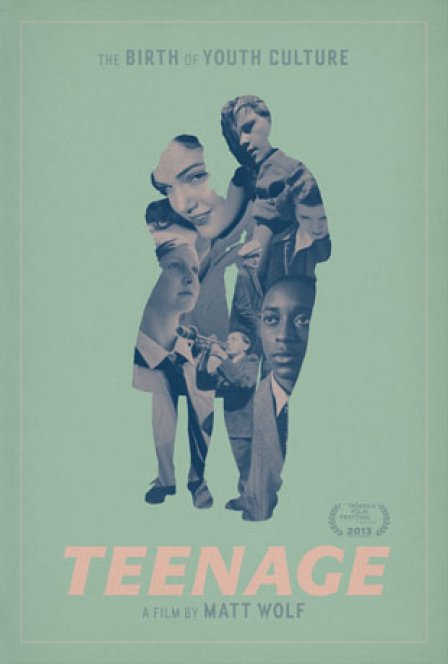Matt Wolf’s new documentary deals with the historical foundations for the contemporary concept of the teenager. Based on the book Teenage: The Creation of Youth: 1875-1945 by punk writer Jon Savage, and with Jason Schwartzman as one of the executive producers (boasted very clearly on the opening credits), Teenage — a collageumentary à la Adam Curtis — certainly arrives with plenty of street cred and makes a fascinating argument, even if it suffers some aesthetic mishaps.
The fast moving film is built upon archival footage and old photographs. The material is cleverly edited and makes for the film’s strongest points, which left me baffled at the questionable aesthetic choice of having original material filmed in such a way as so to resemble grainy archival footage. This faux-vintage footage often suffers from the same issue as the narration, specifically the reading of unquoted sources, most of which appear to be letters and diary entries by teenagers from different historical periods: they occasionally feel too artificial and clash with the slick use of historical visual material. In one particularly Adam Curtis-esque moment, the famous footage of shell shocked twitching soldiers from WWI is followed by a dancing young woman and a dreamy electronica soundtrack by Bradford Cox of Deerhunter and Atlas Sound. A male narrator reads from an unknown source, “The old had sent us to die, and we hated them.” It’s all very seductive and alluring, much like the spirit of youth as seen through the eyes of Matt Wolf and Jon Savage.
In spite of its fast paced editing, Teenage grounds its argument in pinpointed historical landmarks, while at the same time interestingly dismissing the era of the most iconic and recognizable imagery of teenage-hood: the 1960s. It begins its argument in 1904 with the abolition of child labor, which it presents as an important milestone in the history of youth. Without the obligation of having to work at such an early age and with the subsequent mandatory school period, children now had free time and a long period in life before being submitted to adult responsibilities. I’m not a historian with a grasp on the subject of the history of youth, but I’m not fully convinced that 12 year old children working factories in the early 20th century were already considered to be adults. I found myself relativizing and asking if, just like adolescence and youth, child labor as a concept (and as a practice that is frowned upon) could just as well be post-war invention. In such a scenario, it’s not that children would have simply mutated into adulthood in a blink of an eye, but rather that other activities were seen as fit for children as well as adults. The concept of adolescence is a contemporary one, no doubt, but the concept of child has equally changed in drastic forms in the past 100 years.
Anyway, the argument continues: the abolition of child labor led to a rise in vandalism and hooliganism, and thus surfaces Robert Baden-Powell’s founding of the Boy Scouts as a means to provide honor, order and patriotism for this, age-based new sub-class. The organization perfectly introduced a the military mindset to youth in the lead up to the First World War. The film argues that there was a link between the invention of teenagers and war in its very first lines of narration, which serve as the film’s main thesis: “We’re teenagers, but we didn’y always exist. We were a wartime invention.” The wars brought American culture to the rest of the world (and by the rest of the world, Teenage actually means Britain and Germany) and began to pave the way for the internationalization of teenage-hood.
Matt Wolf moves from one country to the next, often by means of a single argumentative thread, but the slick editing of the archival material provides organic transitions. With the help of the allure of his montage choices, we jump from the Boy Scouts in America to the Hitler Youth in Germany. Youth (before teenagers existed) are therefore part of state-constructed identities. The similarities between Boy Scouts, Hitler Youth, and the teenagers of the 1960s may seem far-fetched at first (especially since Teenage hardly ever dwells very long on its logical arguments), but it is not a previously unheard of idea. German sociologist Norbert Elias has already perceived the importance of the State for the construction of youth identities, as well as the similarities between the Hitler Youth, hippies, and the militarized radical left youth movements of the 1960s in his compelling book The Germans.
During its short running time (78 minutes) Teenage makes no attempt at being an all-encompassing take at on such a complex and imbricated subject. At times it seems to spend too much time on both world wars, while its best moments are its great use of its archival material to recreate the overall zeitgeist of a period: the PSAs, the newspaper articles, the mass hysteria, the fear of youth. For a film that could be lauded for avoiding the typical cliché imagery of youth, I was surprised when confronted with a Hitler speech. Teenage just barely gets away with it though, considering that if there’s no proper mediation the insertion of such a loaded scene dangers on being borderline History Channel documentary. That being said, I’ll finish with a Gchat quote by our own Benjamin Pearson: “I felt like this film was what the History Channel should be, if it was on Netflix targeted to TMT readers.”

